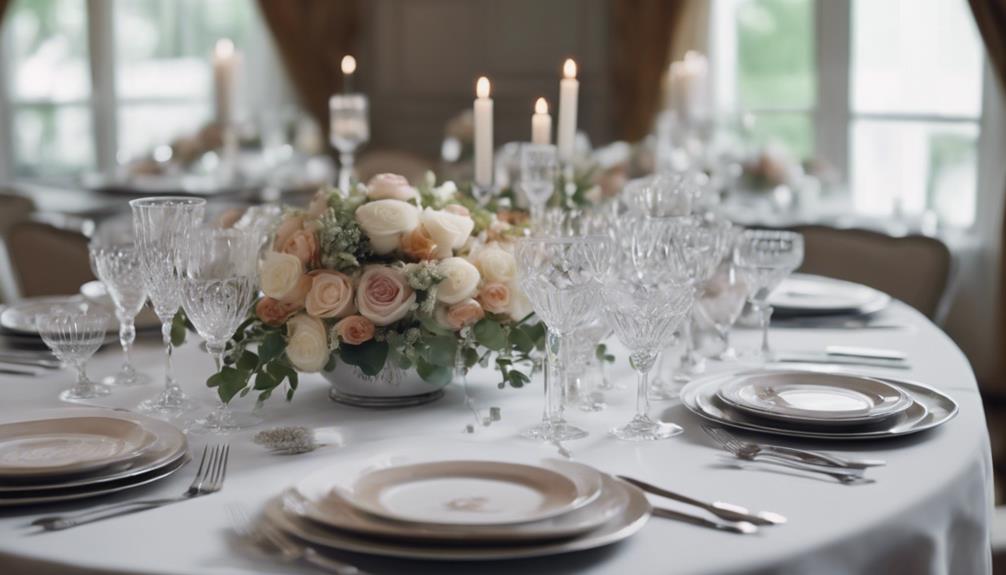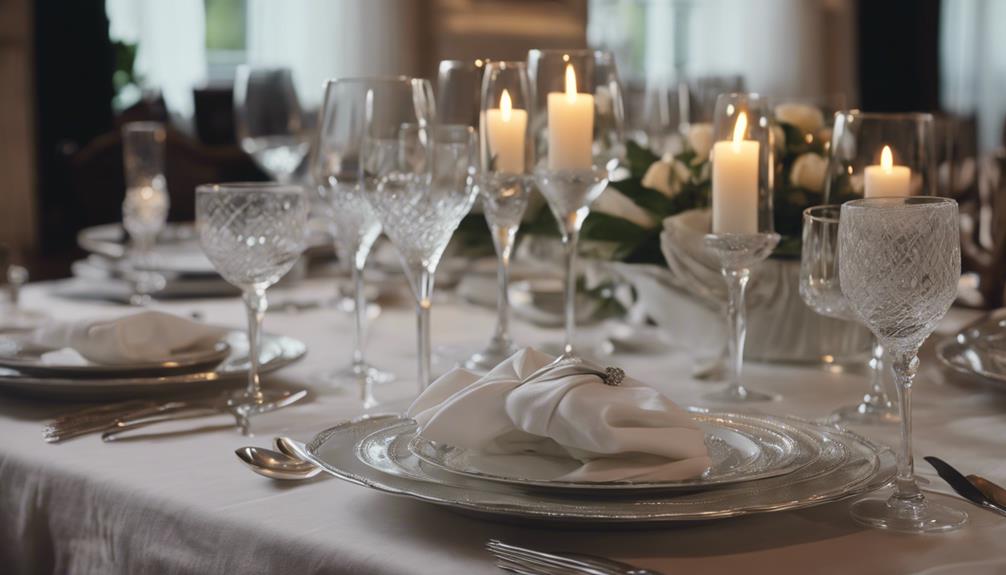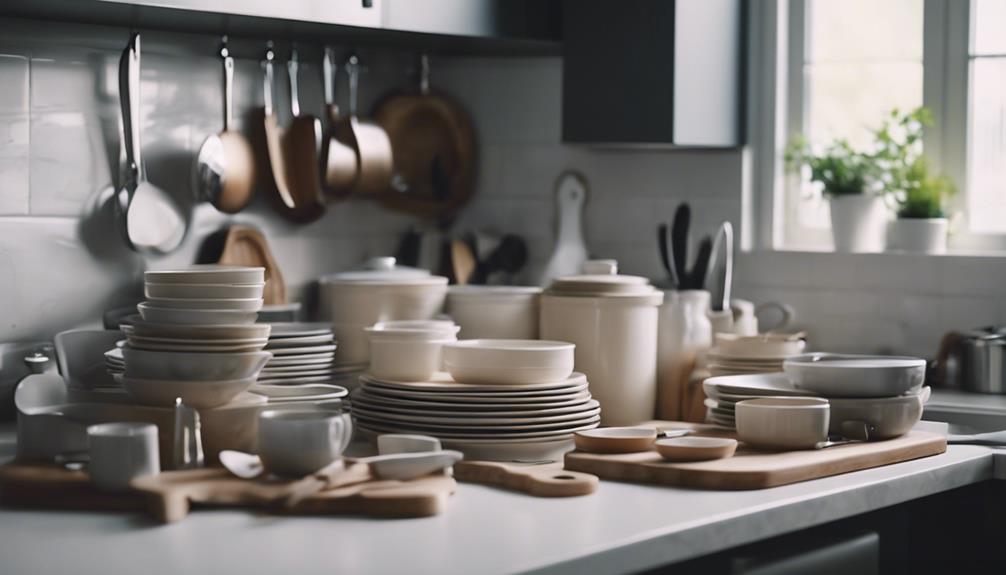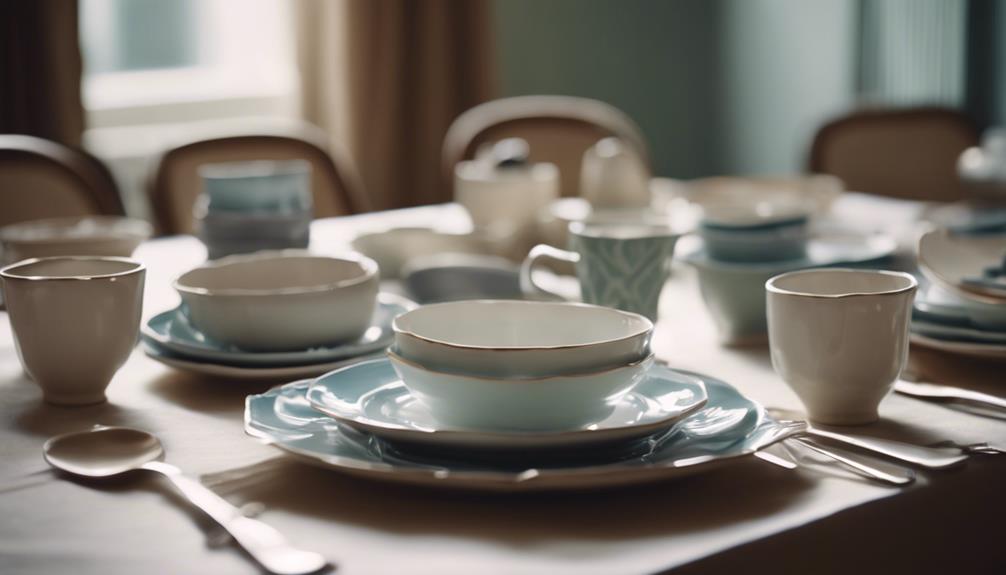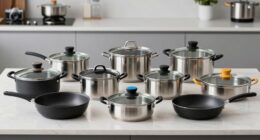When it comes to tableware, there are various materials to consider such as porcelain, plasticware, and stainless steel, each offering unique benefits. Porcelain dinnerware is elegant and resistant to chipping, while plasticware like melamine is practical and long-lasting. Stainless steel is a popular choice for cutlery because of its strength and easy maintenance. Each material has its own distinctive qualities, so choose based on your preferences for style, durability, and maintenance. Explore serveware essentials, dinnerware sets, flatware styles, drinkware options, and eco-friendly choices to personalize your table setting perfectly. Discover more about improving your dining experience with the right tableware selection.
Key Takeaways
- Porcelain: elegant, chip-resistant, delicate appearance
- Plasticware: practical, durable, non-toxic
- Stainless steel: strong, rust-resistant, long-lasting
- Serving platters: showcase culinary creations
- Stylish utensils: elevate presentation, complement serveware
Types of Tableware Materials
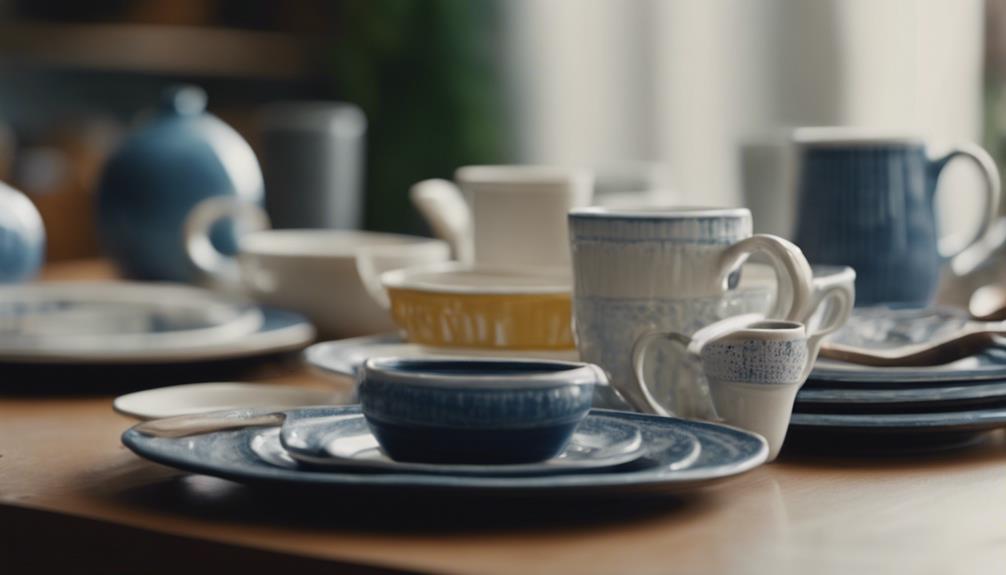
When selecting tableware, consider the various types of materials available to suit your needs and preferences. Porcelain dinnerware is an elegant and durable option that's often considered a step up from basic ceramic. It's known for its delicate appearance, light weight, and chip-resistant quality, making it ideal for both everyday use and special occasions.
Plasticware, made from materials like melamine plastic, offers a practical choice for those seeking durability and resistance to chipping. It's also non-toxic, adding to its appeal for households with young children or outdoor dining scenarios.
Stainless steel is a popular material for cutlery due to its strength, resistance to rust, and ease of cleaning. It's a long-lasting option that can withstand frequent use and dishwashing without losing its shine.
Each of these materials – porcelain dinnerware, plasticware, and stainless steel – brings unique qualities to the table, allowing you to choose based on your preferences for style, durability, and maintenance.
Serveware Essentials
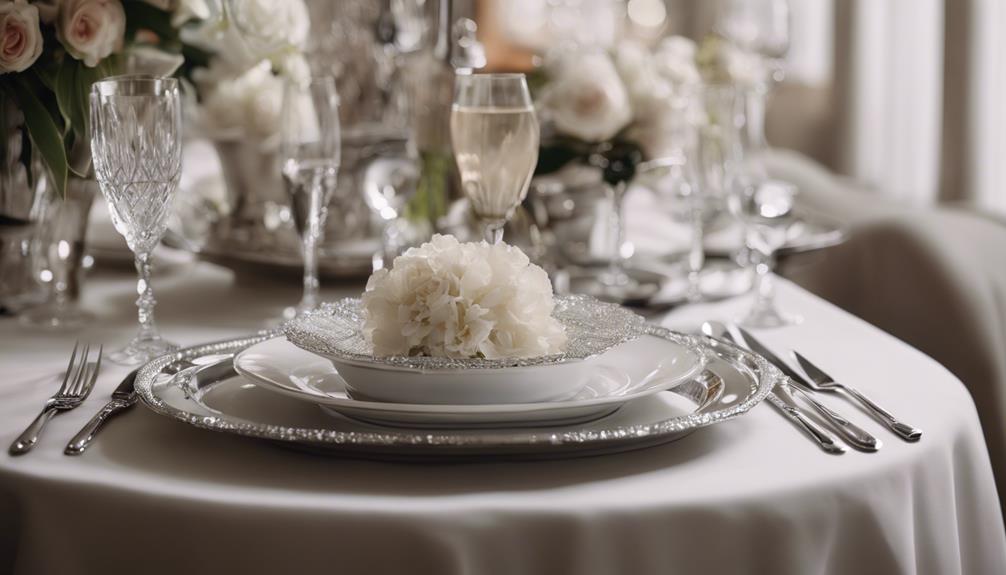
When setting the table, remember that serving platters play a crucial role in showcasing your culinary creations.
Stylish serving utensils not only complement your serveware but also make serving a breeze.
These serveware essentials are essential to elevating your dining experience and impressing your guests.
Serving Platters Selection
Selecting the appropriate serving platter can greatly enhance your dining experience by presenting your dishes in an appealing and elegant manner. Serving platters come in various materials like porcelain, ceramic, glass, or wood, each offering its unique charm to your table setting.
These essential serveware items not only showcase appetizers, main courses, desserts, or a selection of cheeses and fruits but also contribute to the overall visual appeal of your dishes. When choosing serving platters, consider how they complement your table setting to elevate the dining experience for your guests.
Whether you prefer classic porcelain, rustic wood, or modern glass, the right serving platter can add a touch of sophistication and style to your meal presentation.
Stylish Serving Utensils
Stylish serving utensils are indispensable elements in elevating the presentation and sophistication of your dining experience. When it comes to serveware essentials, having the right tools like serving spoons, salad servers, and tongs can make a significant difference. These utensils not only enhance the aesthetics of your table setting but also make serving food more convenient. Investing in quality serveware items helps create a seamless flow between the kitchen and the dining table, adding a touch of elegance to any meal. With various designs and materials available, you can choose serving utensils that suit your style and occasion, ensuring that every dish is served with a hint of flair.
| Serving Spoons | Salad Servers | Tongs |
|---|---|---|
| Elegant design | Stylish look | Versatile |
| Various sizes | Different styles | Easy to use |
| Durable material | Enhances presentation | Convenient |
Choosing Dinnerware Sets

When considering dinnerware sets, be mindful of the material used to make sure it suits both the occasion and your personal preferences. Dinnerware sets typically include plates, bowls, and saucers, providing a coordinated presentation for any dining occasion. For special events, mixing and matching designs within a dinnerware set can create unique table settings, adding an extra touch of elegance to your table. Whether it's a formal dinner party or a casual gathering, choosing the right dinnerware set can elevate the dining experience.
Special occasions like holidays can also be enhanced with themed dinnerware sets, designed to add a festive touch to your tablescapes. These sets often feature intricate designs and colors that complement the celebratory mood. When selecting a dinnerware set, consider the material options available such as Bone China, stoneware, or wood, ensuring that your choice not only looks good but also fits the practical needs of your dining habits. By paying attention to these details, you can create a dining experience that's both visually appealing and functional.
Understanding Flatware Styles
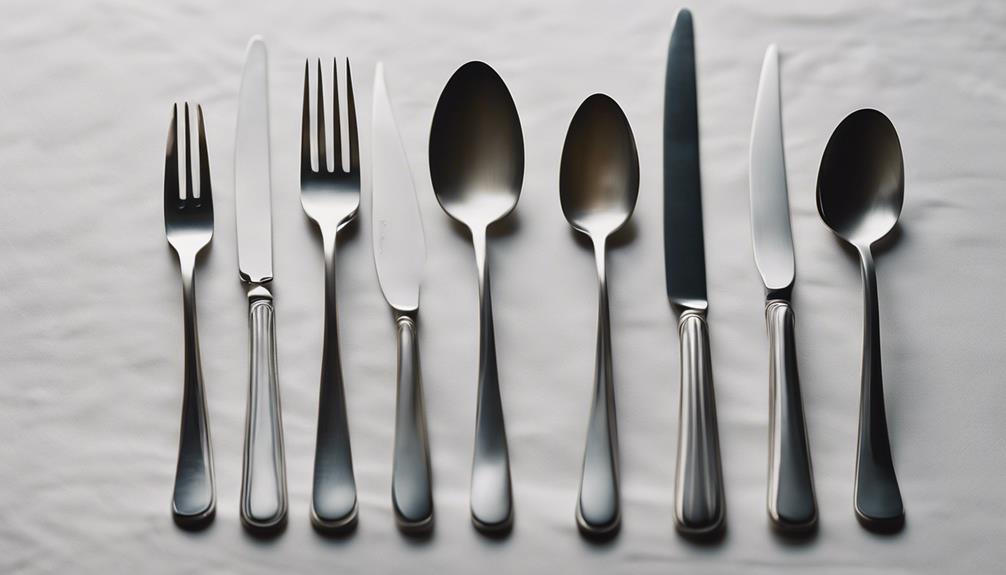
When choosing flatware styles, consider the balance between forks and knives, as well as the distinction between modern and classic designs.
The number of pieces in a set and the finish are also key factors to contemplate.
Whether you opt for a traditional or a more contemporary style, understanding these nuances can help you find the perfect flatware set for your table.
Forks Vs. Knives
Understanding the distinctions between forks and knives is essential for selecting the appropriate flatware styles to enhance your dining experience. Here are some key points to help you differentiate between forks and knives:
- Forks are designed for different meal courses like dinner, salad, and dessert.
- Knives serve specific cutting purposes such as dinner knives, butter knives, and steak knives.
- Flatware styles range from modern to traditional to suit various table settings.
- The material of flatware, like stainless steel or silver-plated, impacts appearance and durability.
Modern Vs. Classic
To navigate between Modern and Classic flatware styles effectively, consider the distinct design elements and materials that define each style's aesthetic appeal.
Modern tableware often showcases sleek and minimalist designs, featuring clean lines and contemporary finishes for a trendy look. Materials like stainless steel, titanium, or matte finishes are commonly used in modern flatware, adding a touch of sophistication to the table setting.
On the other hand, Classic tableware exudes elegance with ornate patterns, intricate details, and traditional shapes that reflect timeless craftsmanship. Classic flatware is typically crafted from silver, gold, or sterling silver, embodying luxury and tradition.
Your choice between modern and classic flatware styles can elevate the dining experience based on personal preferences and the desired ambiance for your table setting.
Selecting Drinkware Options
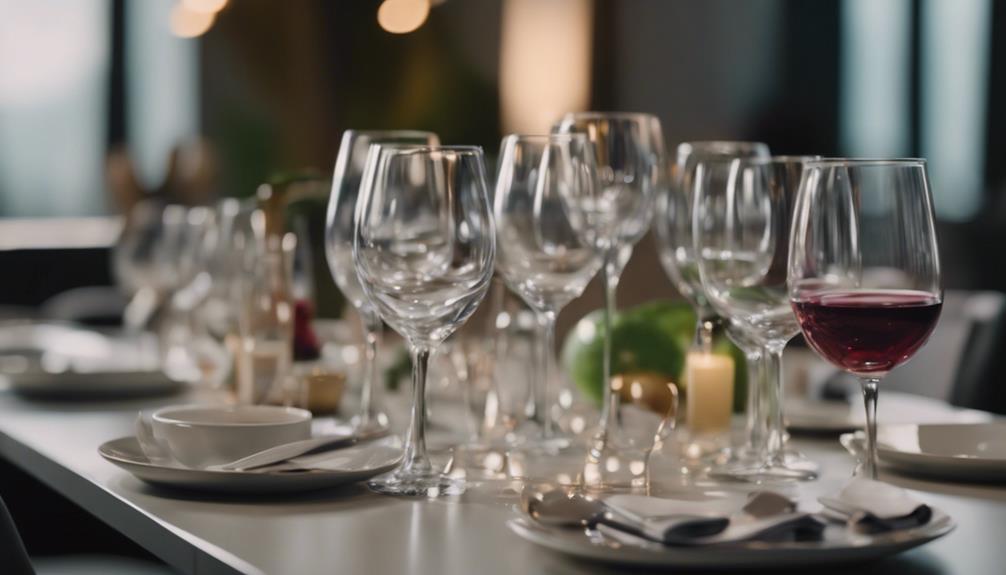
For a well-rounded tableware collection, consider selecting a variety of drinkware options tailored to specific beverages and occasions.
- Wine Glasses: Essential for serving wine, these glasses come in various shapes and sizes to enhance the wine-drinking experience.
- Champagne Flute: Specifically designed for Champagne or sparkling wines, these tall, narrow glasses help preserve the bubbles and showcase the effervescence of the drink.
- Tumblers: Versatile and sturdy, tumblers are perfect for serving water, juices, or mixed drinks in a casual setting.
- Specialized Drinkware: From martini glasses to beer mugs, having specialized drinkware adds a touch of elegance and sophistication to your table setting.
Eco-Friendly Tableware Choices
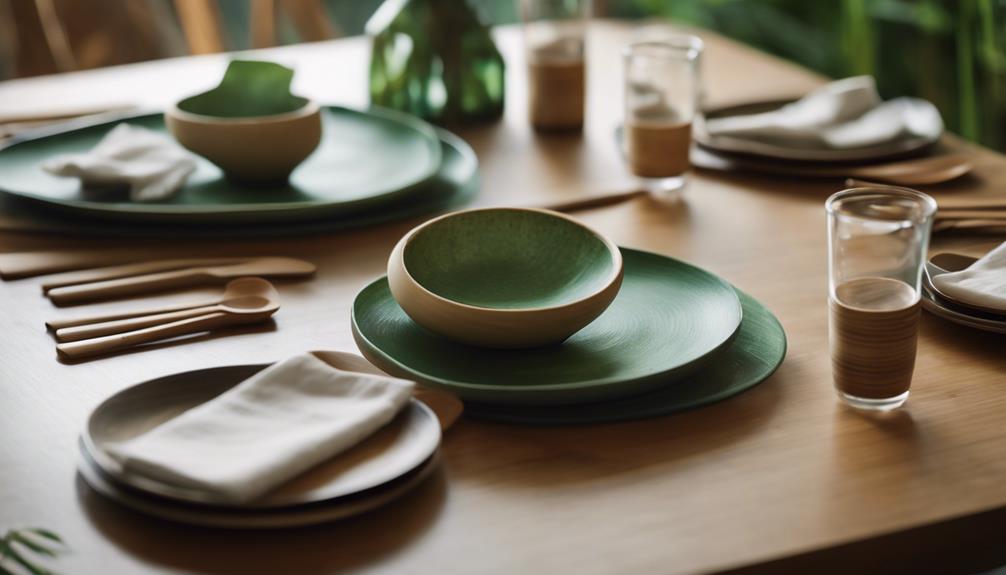
How can you make a sustainable choice when selecting tableware for your next gathering? Opting for eco-friendly tableware is a great way to reduce your environmental footprint. Materials like bamboo, palm leaf, and sugarcane bagasse are not only sustainable but also biodegradable, making them excellent choices for serving dishes. Biodegradable tableware options help combat single-use plastic waste and can be composted after use, contributing to environmental preservation. Additionally, tableware made from recycled materials like paper, cardboard, and plant-based plastics lessen the demand for new resources, promoting sustainability. Choosing eco-friendly alternatives crafted from renewable resources such as cornstarch, wheat straw, and bamboo fibers supports a circular economy. These sustainable tableware options are becoming increasingly popular due to their reduced environmental impact and biodegradability. Consider making the switch to eco-friendly tableware for your next event to make a positive impact on the planet.
| Eco-Friendly Tableware Materials | Benefits |
|---|---|
| Bamboo | Sustainable and biodegradable |
| Palm Leaf | Compostable and eco-friendly |
| Sugarcane Bagasse | Reduces single-use plastic waste |
Frequently Asked Questions
What Are the Basic Tablewares?
Tableware includes serveware for serving dishes, dinnerware for individual portions, flatware for cutlery, and drinkware for beverages. Serveware items like serving bowls and platters aid in meal presentation.
Dinnerware consists of plates and bowls for serving food. Flatware, including spoons, forks, and knives, is essential for dining. Drinkware such as glasses and cups cater to different beverages.
Each type plays a crucial role in enhancing the dining experience and table setting.
What Is Tableware and Examples?
Tableware encompasses various items for dining such as serveware, dinnerware, flatware, and drinkware.
Serveware includes platters and utensils, while dinnerware consists of plates and bowls made from various materials.
Flatware includes forks, spoons, and knives for table settings, and drinkware comprises glasses and cups for beverages.
Each type serves a specific function, enhancing your dining experience. Mixing and matching these pieces can create a beautifully set table for any occasion.
How Are Tableware Classified?
Tableware is classified into serveware, dinnerware, flatware, and drinkware based on their specific functions. Serveware includes items for presenting and serving food, like serving platters and utensils.
Dinnerware consists of plates and bowls made from materials like porcelain. Flatware is cutlery like spoons, forks, and knives, essential for dining. Drinkware includes cups, glasses, and stemware designed for beverages.
Each category serves a distinct purpose in dining settings.
What Are 7 Plates Used For?
When it comes to plates, they play an essential role in serving various courses during a meal. Dinner plates are like the foundation of a meal, holding hearty main dishes. Salad plates are perfect for light starters, while dessert plates showcase sweet treats. Bread plates accompany bread and butter.
Each plate type complements different dining experiences, offering both function and style to your table setting.
Conclusion
To sum up, when it comes to tableware, the options are vast and varied. From classic porcelain dinnerware sets to sleek stainless steel flatware, there's something for every style and preference.
Remember to take into account the material, design, and functionality of each piece before making your selection. Just like a well-set table, choosing the right tableware can bring harmony and elegance to any dining experience.
Choose wisely and enjoy your meals in style.
